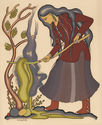
19th, 20th & 21st Century Fine Prints
707-546-7352 · fax 707-546-7924 · web: www.annexgalleries.com · email: artannex@aol.com
Andrew Van Tsinajinnie Biography
Andrew Van Tsinajinnie
American
1918–2000
Biography
Painter and printmaker Andrew "Andy" Van Tsinajinnie was born on the Rough Rock Navajo reservation near Chinle, Arizona, in 1916. In addition to the English name given him (of which there are various spellings), he was known by the nicknames Yazzie Behe and Little Grey. His earliest years were spent learning to care for his family's sheep and horsebackriding. When he was of age, he was sent to the Fort Apache Indian School, but he frequently ran away due to poor treatment by the staff. He was eventually allowed to return to the reservation, and when he was a teenager he enrolled at the Santa Fe Indian School where he was one of the first pupils to study under Dorothy Dunn, founder of "The Studio" art program, designed to teach and promote the work of indigenous youth. He quickly became enthralled with painting and was often found in the school's art studio after hours, when he was made to return to the dormitory. Of his work, Dunn said his was among the best of all of her students.
After graduation, Van Tsihnahjinnie was employed as an illustrator for the Santa Fe Indian Service, and he was given grants by the WPA to design and execute murals in New Mexico and Arizona. In 1940 he joined the Army Air Force and was sent to the South Pacific the following year, as the U.S. entered into World War II. Upon his return, he opened a studio in Scottsdale, Arizona, and was a self employed artist for the rest of his life. He died in 2000.
He would become known for an ever-evolving style that always focused on his Dine (Navajo) roots, depicting ceremonies and daily lives of the Navajo, and working in oils, watercolor, printmaking, and sculpture. He's considered one of the most successful Navajo artists of his time and one of the leading modern American Indigenous artists of the 20th century. His works are held in the permanent collections of the Denver Art Museum; Thomas Gilcrease Institute of American History and Art, Tulsa, OK; the Heard Museum, Phoenix, AZ; the Museum of Northern Arizona, Flagstaff, AZ: the Philbrook Museum of Art, Tulsa, OK; Millicent Rogers Foundation Museum, Taos, NM; the Smithsonian Institution, Washington, D.C.; the Wheelwright Museum of the American Indian, Santa Fe, NM; and the C.N. Gorman Museum at UC Davis, Davis, CA.

